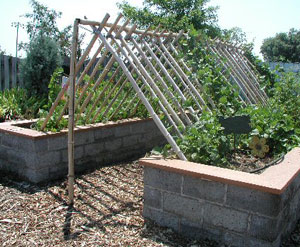Phaseolus spp.
“Beans, beans are good for your heart, the more you eat… etc.”. Conveniently I have forgotten the rest of that ditty but it’s true that beans are good for your heart, bones and all over “well-ness”. Growing beans is really good for your Yummy Yard because they are easy to grow and produce stacks of beans. They are a climber so are excellent where space is an issue!
Planting Schedule
Warm Areas: All Year
Temperate Areas: September to January
Cool to Cold Areas: September to January
Position, Position, Position
Full sun is the order of the day for beans but provide a bit of temporary shade cover in super-hot, dry, windy weather. As most beans are climbers (unless you go for the dwarf or “bush beans”), you need to think about that before you whack them in. They need support as they get up to about 2m high. A wire trellis, fence lines, frames or similar can be used to prop them up. Why not make a tee-pee, or an A-frame walkway to grow your beans along? They look awesome, the kids will love them and they’ll add some real height and interest to your Yummy Yard.
Talking Dirty
Like my ideal partner, soil for beans should be rich, deep, pH neutral and organic. Compost is perfect (not as a partner – as a soil improver) for soil preparation. You could also use an organic, complete pelletised fertilizer at planting time. Mulching your bed is really important but ensure the mulch doesn’t touch the stems of the beans, as this can lead to bad things happening! Soil needs to be well-drained but note that beans don’t really like sandy soils very much. So improve your sandy soil with nicely aged compost.

Feed Me
Feeding beans is totally unnecessary except for a wee bit of blood and bone sprinkled around at planting time. Make sure seedligs don’t come in direct contact with the Blood and Bone. Beans have a wonderful relationship with bacteria in the soil that enables them to ‘fix’ their own nitrogen from the atmosphere. Feeding beans with a nitrogen rich fertilizer can harm these bacteria and also reduce bean production… all in all a pointless exercise. Feed with a seaweed tea at flowering time to promote higher yields of tasty beans!
What about the Water?
The biggest water issue with beans is not so much under-watering but over-watering. That’s right, people are killing their bean stalks with love! Overwatering is a significant issue if planting beans from seed or when seedlings are very young. Leaves can become really yellow if drainage is poor and the plants are getting too much water so keep an eye on this. When planting seed, whack them in a damp (not soaking) soil, then leave them for a few days! Too easy! Soaking seeds of beans in water before planting is totally unnecessary and is a deadset waste of time and water.
Are We There Yet?
Depending on the varieties of beans you have planted, expect to be chowing down on bundles of beans between 12 – 14 weeks (10 weeks if you’ve gone the dwarf varieties). Pick bean pods when they are young, tender and at their tastiest. Do this before the seeds have swollen to make the pod lumpy and they’ll taste better. It’s best to harvest manageable numbers of beans regularly as this will promote more flowering and more tasty bean pods. I collect beans every three days… this seems to work out pretty well!
Pests and the Rest
Look, beans are dead simple to grow but it doesn’t mean that they are without their issues. We’ve seen that they don’t like too much water, dislike too much fertilizer and hate being touched by mulch. There are a couple of other things to keep an eye on, like fuzzy stuff on the leaves. This is probably powdery mildew and this can be caused by humidity, water on the foliage or poor air circulation. An easy solution is when you plant your beans to give them some “personal space”. We all need room to breathe, beans included. Try to avoid watering the leaves as another good preventative measure.
Halo blight is another funky fungal issue and first appears as leaf spots with holes. Leaves will eventually progress to becoming light green with dark green veins and it will eventually kill infected plants. The best thing to do here is to remove and destroy all infected plants (but not into the compost). Plant your replacement bean seeds in a different spot.
Hot Tip
Let’s talk green manures! Green manure is essentially a crop grown in a patch (or on a farm) that acts to improve the nutrient content and organic matter in the soil. Beans, peas, clovers, lupins and alfalfa are all legumes – plants that have a relationship with nitrifying soil bacteria. So growing any of them will assist in “fixing” atmospheric nitrogen and returning it to the soil. With legumous green manures, the idea is to plant seeds of these plants (they can be bought premixed) and let them grow until they begin to flower. I then whack them with the whipper snipper, and allow the slashed plants to lie on the surface of the soil or just tilled in. Do not plant in your green manure bed for at least 6 weeks after slashing. Green manures are a top, sustainable way of improving your soil.
Related Articles:
Tomato Brown Rugose Fruit Virus (ToBRFV)
Tomato Brown Rugose Fruit Virus (ToBRFV) is a plant virus that causes severe crop losses (up to 75%) in tomatoes, but also in peppers (capsicums and…
Garden Journaling – Slow down to tune in.
As we move through the year and our gardens evolve, there's something magical about documenting the journey. Garden journaling is an art that enables…


